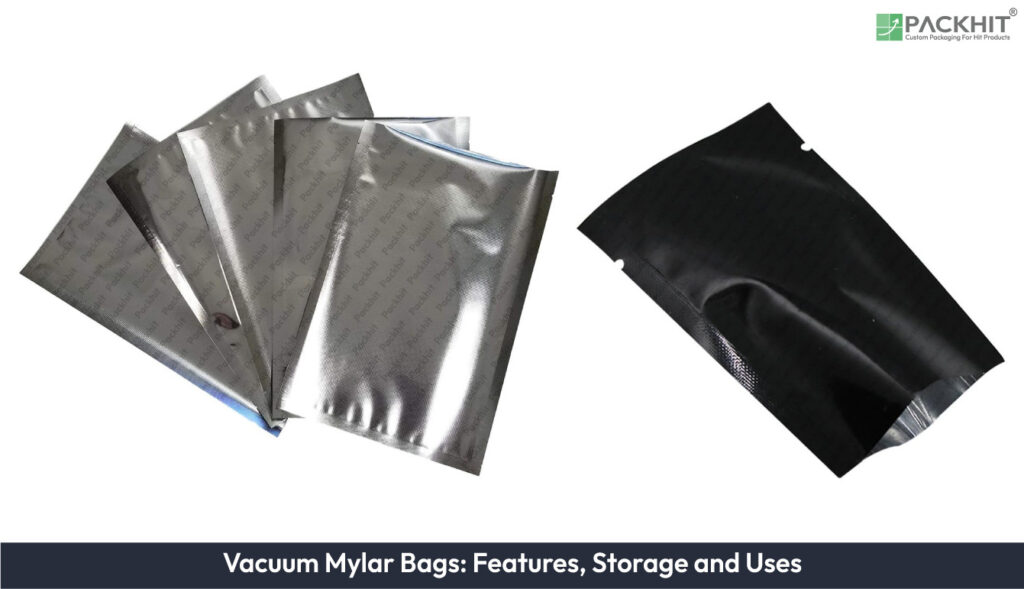Vacuum Mylar bags are specialized packaging solutions that combine the high barrier protection of BoPET (Mylar) film with the air-removal benefits of vacuum sealing, creating an airtight environment ideal for long-term preservation. These bags feature exceptional resistance to oxygen, moisture, light, and volatile compounds, along with strong structural integrity and customizable options such as various sizes and resealable features. The vacuum-sealing process eliminates air, preventing spoilage, oxidation, and microbial activity while also reducing storage volume through compression. Commonly used in food preservation, pharmaceuticals, electronics, and archival storage, vacuum Mylar bags offer reliable protection for sensitive items, ensuring extended shelf life and safeguarding against environmental damage.
- What are Vacuum Mylar Bags?
- What are the Features of Vacuum Mylar Bags?
- Material Composition and Barrier Properties
- Airtight Sealing Capability
- Durability and Structural Integrity
- Customization Options
- Lightweight and Space-Efficient Design
- How Do Vacuum Mylar Bags Preserve Stored Items?
- What are the Primary Uses of Vacuum Mylar Bags?
What are Vacuum Mylar Bags?
Vacuum Mylar bags are a specialized type of packaging that combines the durable characteristics of Mylar, a biaxially-oriented polyethylene terephthalate (BoPET) film, with the air-removal process of vacuum sealing. This pairing results in a packaging solution that provides an airtight barrier against environmental elements such as oxygen, moisture, and light, ensuring optimal preservation for a wide range of items. Vacuum Mylar bags are particularly valued in industries that demand long-term storage and protection, such as food preservation, pharmaceuticals, and electronics.
What are the Features of Vacuum Mylar Bags?
Vacuum Mylar bags offer distinct material and functional attributes that make them highly effective for preservation and packaging. These features are critical for maintaining the integrity and longevity of stored items, especially in industries demanding airtight and durable packaging solutions.
The features of vacuum mylar bags are discussed below:
Material Composition and Barrier Properties
The core material of vacuum Mylar bags is Mylar, a biaxially-oriented polyethylene terephthalate (BoPET) film known for its high tensile strength and chemical resistance. This material provides an exceptional barrier against oxygen, moisture, light, and volatile organic compounds (VOCs), ensuring optimal protection for the contents within. The multi-layered construction often incorporates additional barrier films to enhance impermeability and resilience.
Airtight Sealing Capability
Vacuum Mylar bags are designed to support vacuum sealing, which removes air from the packaging. This airtight environment prevents oxidation, microbial activity, and spoilage, making the bags ideal for storing perishable goods and sensitive materials. The heat-sealing process ensures the vacuum remains intact, even in fluctuating environmental conditions.
Durability and Structural Integrity
The durable nature of Mylar film ensures that vacuum Mylar bags resist punctures, tears, and abrasions. This characteristic is essential for applications involving heavy or sharp items, such as industrial components or electronic devices. Additionally, the bags maintain their structural integrity over extended periods, even under high-stress conditions.
Customization Options
Manufacturers can customize vacuum Mylar bags to meet specific requirements. Options include varying thickness levels, sizes, and the addition of features like resealable zippers or gusseted bottoms. These adaptations enhance usability and cater to diverse packaging needs across industries.
Lightweight and Space-Efficient Design
The lightweight design of vacuum Mylar bags, combined with their ability to compress during vacuum sealing, reduces overall storage volume. This space-efficient characteristic is particularly beneficial for bulk storage or transportation, minimizing costs and logistical challenges.
How Do Vacuum Mylar Bags Preserve Stored Items?
The preservation capabilities of vacuum Mylar bags are rooted in their ability to create an airtight environment. By removing air, the vacuum-sealing process eliminates oxygen, which is a primary driver of spoilage, oxidation, and microbial activity. This mechanism is particularly effective for perishable goods, such as food, where the absence of oxygen significantly extends shelf life.
The multi-layered barrier of Mylar prevents the ingress of moisture, light, and volatile organic compounds (VOCs), further safeguarding the contents. For instance, in pharmaceutical storage, these properties ensure that active ingredients remain stable over extended periods. Similarly, in electronics packaging, the bags protect components from corrosion caused by humidity and airborne contaminants.
Vacuum-Sealing Process
The vacuum-sealing process involves placing the item inside the Mylar bag, extracting air using a vacuum sealer, and then heat-sealing the bag to maintain the vacuum. This process not only removes oxygen but also compresses the bag around the contents, reducing the overall volume and making storage more space-efficient. The heat-sealing step ensures that the vacuum remains intact, even under fluctuating environmental conditions.
What are the Primary Uses of Vacuum Mylar Bags?
Vacuum Mylar bags are employed across a wide range of industries due to their versatile protective properties. Below are some of the most common applications of vacuum Mylar bags:
Food Storage and Preservation
In the food industry, vacuum Mylar bags are used to extend the shelf life of perishable items such as meats, grains, and dehydrated foods. The bags prevent oxidation, moisture absorption, and pest infestation, making them ideal for long-term storage. For example, freeze-dried meals stored in vacuum Mylar bags can remain edible for up to 25 years under proper conditions.
Pharmaceutical and Medical Applications
Pharmaceutical manufacturers use vacuum Mylar bags to store active pharmaceutical ingredients (APIs) and finished products. The bags’ impermeability to moisture and light ensures the stability and efficacy of sensitive compounds. In medical settings, sterilized instruments are often vacuum-sealed in Mylar bags to maintain sterility until use.
Industrial and Electronics Packaging
In industrial applications, vacuum Mylar bags are used to protect metal components from corrosion and oxidation. For electronics, the bags shield sensitive components from static electricity, moisture, and dust. For instance, semiconductor manufacturers often rely on vacuum Mylar bags to package integrated circuits and other delicate components.
Archival and Document Preservation
Vacuum Mylar bags are also employed in archival settings to preserve historical documents, photographs, and artwork. The bags’ ability to block light, moisture, and air ensures that these items remain in pristine condition over decades.

